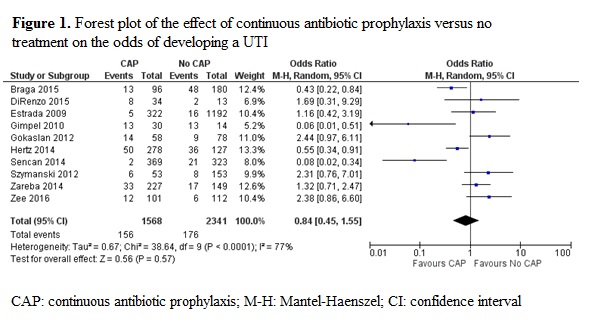Back to 2017 Program
Continuous antibiotic prophylaxis for urinary tract infections in prenatal hydronephrosis: A systematic review and meta-analysis
Bethany Easterbrook, B.Kin1, Derek M. Bos, MD
2, Katey Savage, BSc
1, J P. Capolicchio, MD
3, Armando J. Lorenzo, MD
4, Luis H. Braga, MD
1.
1McMaster University, Hamilton, ON, Canada,
2McMaster Children's Hospital, Hamilton, ON, Canada,
3Montreal Children's Hospital, Montreal, QC, Canada,
4The Hospital for Sick Children, Toronto, ON, Canada.
Introduction: While continuous antibiotic prophylaxis (CAP) is recommended to prevent urinary tract infections (UTI’s) in infants with prenatal hydronephrosis (HN), this recommendation is not evidence based. Herein, we attempted to systematically assess current literature to determine whether CAP reduces UTI’s in patients with prenatal HN.
Methods: Applicable trials were identified through an electronic search of MEDLINE (1948-2015), EMBASE (1980-2016), CINAHL (1982-2016), and CENTRAL (1993-2016) and through a hand search of American Urological Association (2012-2015), European Society of Pediatric Urology (2012-2015) abstracts and reference lists of included trials. The search strategy was not limited by language or year of publication. Eligible studies compared CAP versus no CAP in male and/or female infants < 2 years of age, and included grade of HN and development of UTI for all patients. Two independent reviewers performed title and abstract screening, full text review and quality appraisal.
Results: Of 1518 citations screened, 10 full studies were included, contributing 3909 patients for final analysis. Of these, three (30%) were considered high quality when assessed by the Newcastle Ottawa Scale. Meta-analysis of non-randomized trials (n=10) provided similar pooled UTI rates, regardless of CAP use: 9.9% (95% CI: 8.4% to 11.4%) overall for CAP and 7.5% (95% CI: 6.4% to 8.6%) without CAP. The forest plot for CAP versus no CAP (Figure 1) showed a pooled odds ratio of 0.84 (95% CI: 0.45-1.55). The pooled UTI rate for high-grade hydronephrosis was 21% (95%CI: 17.2, 24.7) compared to 10.5% (95%CI: 8.2, 12.7) for low-grade hydronephrosis, confirming previous findings (Figure 2). A significant degree of heterogeneity existed among included studies, as evidenced by an I2 of 77%. Heterogeneity may have been due to very low-quality data and lack of randomization in all included studies.
Conclusion: This systematic review and meta-analysis suggests there may be value in providing CAP to infants with high grade HN, however, due to high heterogeneity and low quality of included studies, the results of this systematic review should be interpreted with caution.


Back to 2017 Program





